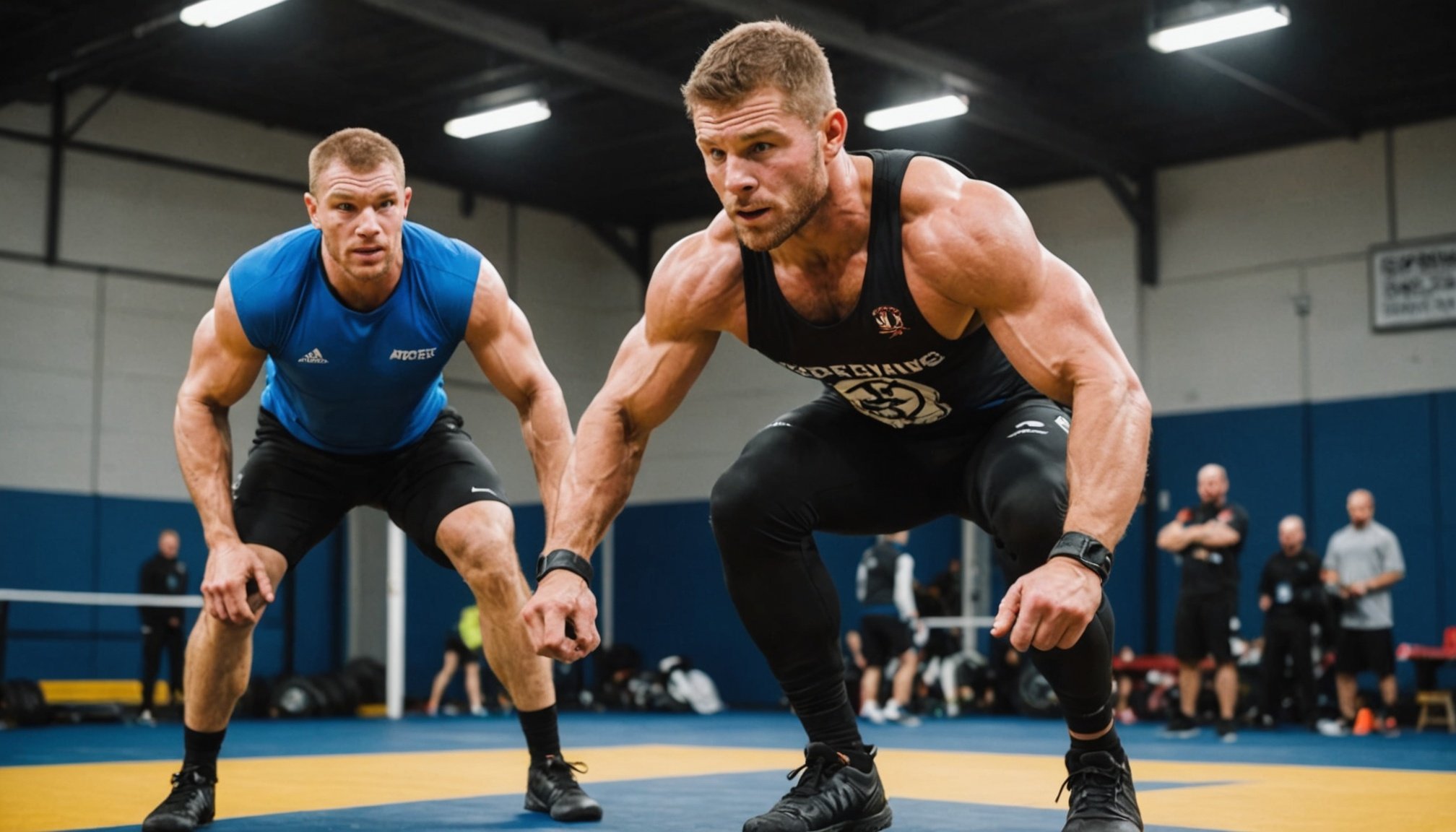Understanding Plyometrics for Wrestlers
Plyometric training is vital for wrestlers aiming to enhance explosive strength and overall wrestling performance. Plyometric training involves exercises that enable muscles to exert maximum force in short intervals, focusing on speed-strength development. Through these exercises, athletes can improve their ability to perform quick, powerful movements, which is essential in wrestling scenarios such as takedowns and escapes.
Explosive strength is a cornerstone of effective wrestling performance. Wrestlers must generate rapid muscle contractions to propel themselves aggressively and overcome their opponents during a match. This ability directly correlates with the efficiency and power of movements in competitive wrestling, where agility and speed are paramount.
This might interest you : Turbocharged Reflexes: UK Fencing Athletes’ Techniques for Lightning-Fast Reactions in Competition
By incorporating plyometric training, wrestlers can significantly enhance their athletic performance. This form of training enhances neuromuscular efficiency, thereby reducing reaction time and increasing force production. Wrestlers who consistently engage in plyometric exercises can expect improvements in their vertical jump, agility, and overall power, translating to better performance on the mat.
Incorporating plyometrics into a workout routine can revolutionize an athlete’s approach to wrestling, providing them with the tools needed for superior strength and agility. Understanding the principles and benefits of plyometrics sets the foundation for a more robust, competitive wrestling performance.
Additional reading : Harnessing Victory: How Visualization Strategies Boost Performance for UK Combat Athletes
Essential Plyometric Exercises for Wrestlers
Plyometric exercises play a key role in boosting a wrestler’s athletic strength and functionality. Dividing these exercises into lower body, upper body, and core segments facilitates a well-rounded training approach.
Lower Body Plyometrics
For wrestlers, lower body plyometrics target explosive movements crucial for effective takedowns and dodges. Exercises like box jumps and depth jumps enhance leg strength and power. Box jumps involve jumping onto a raised platform, focusing on quick, powerful launches. Maintain a soft landing to reduce strain on the joints, ensuring safety and technique.
Upper Body Plyometrics
Upper body plyometrics, like clap push-ups and medicine ball throws, promote powerful movements critical for clinches and throws. Clap push-ups enhance chest and tricep strength; perform with controlled form to minimize injury risk. Medicine ball throws concentrate on core stability— essential for countering opponent maneuvers.
Core Plyometrics
Core exercises such as Russian twists and plank slams fortify those stabilizing muscles necessary for maintaining balance during a match. Focus on maintaining form to maximise effectiveness, keeping movements controlled yet dynamic. Adjust difficulty by increasing weights or repetitions, aligning progression with skill advancement. This comprehensive focus on plyometrics significantly enhances a wrestler’s overall prowess on the mat.
Designing a Plyometric Training Program
A structured training program is crucial for maximizing the benefits of plyometric exercises. The first key component is establishing a solid workout structure that efficiently targets various muscle groups. Essential to this are set and rep schemes that vary according to a wrestler’s performance goals.
For beginners, starting with a foundational structure, such as two to three sets of eight to ten repetitions, allows for mastering technique while building basic explosive strength. Intermediate and advanced wrestlers can increase intensity by adjusting the volume and introducing more complex movements.
Incorporating adequate rest periods between exercises aids in recovery and reduces injury risk, thereby enhancing overall workout effectiveness. Tailoring volume and intensity based on experience level is fundamental in preventing overtraining, allowing athletes to progressively build strength without compromising safety.
A balanced plyometric training program also emphasises dynamic warm-ups and cool-down routines, preparing the body for vigorous movements and aiding in post-exercise recovery. Continuously adjusting exercises to align with training progression ensures that wrestlers remain challenged, ultimately improving their athletic performance.
Including these components in a training program empowers wrestlers to harness the full potential of plyometrics, improving their efficiency and strength on the mat.
Sample Plyometric Workouts
Creating effective plyometric sessions involves careful planning to ensure optimal training plans. A structured week-by-week training plan should incorporate varied workouts for comprehensive development. Each plan intertwines exercises targeting different muscle groups, promoting overall fitness and strength required for wrestling.
For full-body conditioning, a well-balanced plan includes a mix of exercises that advance in complexity and intensity throughout the weeks. Monday might focus on lower-body exercises like box jumps, while Wednesday pivots to upper-body workouts such as plyometric push-ups. A combined session on Friday would integrate core-focused moves like plank slams. By scheduling strategic rest days, athletes maintain peak performance without overtraining.
To integrate plyometrics efficiently with wrestling practice, athletes can apply these sessions at the beginning of training. This approach ensures that technique is not compromised by fatigue. Further, altering the exercises and their sequence can keep workouts fresh and engaging, avoiding monotony while ensuring consistent progress.
What’s essential in any workout example is the adaptability according to individual needs and goals. Customizing plyometric sessions allows wrestlers to address specific areas for improvement, gearing them for enhanced agility, strength, and overall performance on the mat.
Safety Considerations in Plyometric Training
Ensuring training safety is crucial in plyometric training, an intense form of exercise known for potential stress on muscles and joints. Common injuries include ankle sprains, knee strains, and tendonitis, often resulting from improper techniques or overexertion. Injury prevention starts with understanding the importance of maintaining proper form during exercises.
To mitigate injury risk, athletes should engage in comprehensive warm-up routines before beginning plyometric drills. These routines prepare muscles and joints, increasing their flexibility and reducing the likelihood of injuries. Equally vital are cool-down practices, which help return the body to its pre-exercise state, flushing out lactic acid that can contribute to soreness.
Guidelines include initiating plyometric routines with simpler exercises and gradually advancing to more complicated movements. This progression helps athletes build strength and improve their form, lessening the stress placed on their bodies. Throughout each exercise, maintaining proper alignment and avoiding excessive joint impact are fundamental.
Training safety also involves monitoring fatigue levels and ensuring adequate rest between sets. Overexertion is a common cause of injuries, so listening to one’s body is paramount in promoting a safe and effective plyometric training experience. Integrating these safety measures will foster a controlled environment conducive to enhancing explosive strength without compromising health.
Nutritional Guidance for Explosive Performance
In wrestling, where plyometric training and explosive strength are paramount, nutrition plays a vital role in enhancing performance. An optimal diet focuses on satisfying the athlete’s dietary needs for fuel and recovery. Wrestlers should prioritise a macronutrient balance: a diet incorporating carbohydrates, proteins, and fats. Carbohydrates are crucial for energy, especially during high-intensity bouts, while proteins aid muscle repair and growth. Healthy fats provide sustained energy and support overall health.
Hydration is a pivotal aspect of maintaining performance enhancement. Wrestlers should drink adequate fluids before, during, and after training to prevent dehydration, which can impair performance. Electrolyte replacement drinks and water are effective choices for maintaining hydration status during intense sessions.
Pre- and post-workout nutrition for athletes is essential for ensuring consistent performance and recovery. A pre-workout snack rich in carbs and moderate proteins, consumed about 30-60 minutes before training, prepares muscles for action. Post-workout, a combination of proteins and carbs within 30 minutes can expedite recovery. Examples include a protein shake with a banana or a chicken sandwich with whole-grain bread.
Tailoring nutritional strategies to individual goals and training demands can significantly impact a wrestler’s performance on the mat.
Nutritional Guidance for Explosive Performance
Proper nutrition is a cornerstone of an athlete’s ability to harness explosive strength effectively. A robust nutrition plan tailored to meet the dietary needs of wrestlers can significantly impact wrestling performance. A strategic macronutrient breakdown ensures wrestlers receive optimal energy and recovery benefits.
Carbohydrates play a pivotal role in fueling high-intensity training sessions, while proteins are vital for muscle repair and growth. Healthy fats, although often overlooked, support prolonged energy release and hormone production. Balancing these macronutrients according to an athlete’s energy demands is crucial.
Hydration is equally important, especially given the rigorous nature of plyometric training. Adequate fluid intake before, during, and after workouts maintains performance levels and aids in recovery. Incorporating electrolyte-rich drinks can prevent dehydration and improve endurance during challenging sessions.
Pre-workout nutrition emphasizes carbohydrate-rich meals, paired with moderate protein intake, to energize athletes without causing discomfort. Post-workout meals focus on replenishing glycogen stores and promoting muscle recovery through a combination of proteins and carbohydrates.
By meticulously planning their dietary intake, wrestlers can support their body’s physical demands, optimize training outcomes, and enhance overall wrestling prowess. This nutritional strategy not only prepares athletes for the physical strain of wrestling but also boosts their resilience and performance on the mat.




